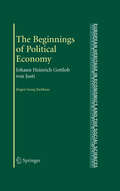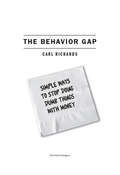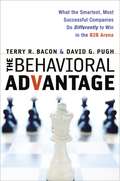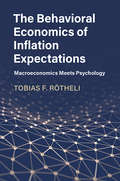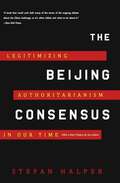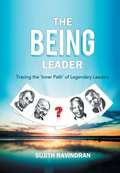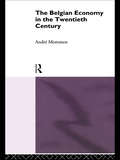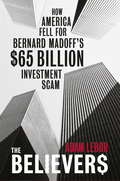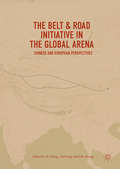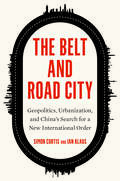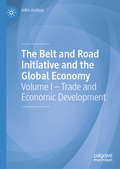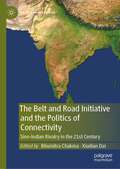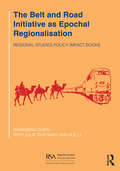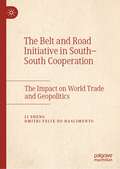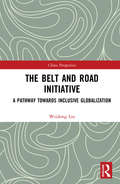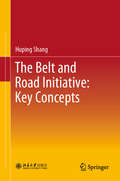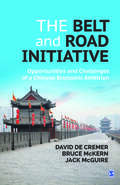- Table View
- List View
The Beginnings of Political Economy
by Jürgen Georg BackhausThis volume contains eleven essays on Johann Heinrich Gottlob von Justi's concepts of the modern economy. These essays reflect both Justi's life and professional work, focusing on his ideas on economics and social sciences. Interesting are the aspects of his biography that gave rise to the development of his economic thought. Apart from Justi's personal background, this book contains the beginning of modern economics because Justi's philosophy was linked to government, labour, morality, health and finally the good society. Justi, throughout his life, had a dual career of being on the one hand a prolific writer and educator, on the other hand an administrator in the core state business of mining, then an important revenue source, and he typically combined the two. He gave two inaugural lectures in 1750 in front of Queen and Empress Maria Theresia. The lecture on cameral sciences is truly the beginning of modern economics: Justi was of the opinion that the happiness of the state would be increased if the number of happy and healthy persons would increase. For this reason, health was a major focus of his attention long before the advent of health economics. The main benefit the reader will derive from the book is an understanding of how economics developed as a separate science. Furthermore, they will see how Justi laid the foundation for policy sciences, the specialty of many schools of governement today.
The Behavior Gap: Simple Ways to Stop Doing Dumb Things with Money
by Carl Richards"It's not that we're dumb. We're wired to avoid pain and pursue pleasure and security. It feels right to sell when everyone around us is scared and buy when everyone feels great. It may feel right-but it's not rational. " -From The Behavior Gap Why do we lose money? It's easy to blame the economy or the financial markets-but the real trouble lies in the decisions we make. As a financial planner, Carl Richards grew frustrated watching people he cared about make the same mistakes over and over. They were letting emotion get in the way of smart financial decisions. He named this phenomenon-the distance between what we should do and what we actually do-"the behavior gap. " Using simple drawings to explain the gap, he found that once people understood it, they started doing much better. Richards's way with words and images has attracted a loyal following to his blog posts for The New York Times, appearances on National Public Radio, and his columns and lectures. His book will teach you how to rethink all kinds of situations where your perfectly natural instincts (for safety or success) can cost you money and peace of mind. He'll help you to: avoid the tendency to buy high and sell low; avoid the pitfalls of generic financial advice; invest all of your assets-time and energy as well as savings-more wisely; quit spending money and time on things that don't matter; identify your real financial goals; start meaningful conversations about money; simplify your financial life; stop losing money! It's never too late to make a fresh financial start. As Richards writes: "We've all made mistakes, but now it's time to give yourself permission to review those mistakes, identify your personal behavior gaps, and make a plan to avoid them in the future. The goal isn't to make the 'perfect' decision about money every time, but to do the best we can and move forward. Most of the time, that's enough. "
The Behavior of Non-Oil Commodity Prices
by Carmen M. Reinhart Mohsin S. Khan Peter Wickham Eduardo BorenszteinThis paper analyzes global commodity trends and concludes that the marked decline in real commodity prices of the past decade should be regarded as largely permanent and irreversible. the authors contend that the analysis of commodity prices should be extended to include the role of the breakdown of major international commodity agreements. In addition, the authors analyze how developments in the former Soviet Union have affected commodity supply conditions.
The Behavioral Advantage: What the Smartest, Most Successful Companies Do Differently to Win in the B2B Arena
by David Pugh Terry BaconIn their book Winning Behavior, Terry Bacon and David Pugh showed how great companies outperform good ones through "behavioral differentiation" -- going beyond superior products and dependable service to connect with customers at every touchpoint. The Behavioral Advantage broadens the concept, applying behavioral differentiation to the business-to-business arena.The best B2B companies depend on a multifront approach to business interaction, and The Behavioral Advantage reveals the secrets behind what is essentially a chess game with competitors. To win the game, companies must develop a carefully plotted opening game, with all internal values, policies, practices, and behaviors fully aligned. A smart and efficient middle game lets the company build and strengthen its position, and the endgame assures victory and lays the groundwork for future business.Just as individual customers do, B2B customers remember those companies whose behavior consistently and significantly outshines even strong competitors. These firms create a lasting advantage -- and reap the profits that come with it.
The Behavioral Economics of Inflation Expectations: Macroeconomics Meets Psychology
by Tobias F. RötheliAs one of the first texts to take a behavioral approach to macroeconomic expectations, this book introduces a new way of doing economics. Rötheli uses cognitive psychology in a bottom-up method of modeling macroeconomic expectations. His research is based on laboratory experiments and historical data, which he extends to real-world situations. Pattern extrapolation is shown to be the key to understanding expectations of inflation and income. The quantitative model of expectations is used to analyze the course of inflation and nominal interest rates in a range of countries and historical periods. The model of expected income is applied to the analysis of business cycle phenomena such as the great recession in the United States. Data and spreadsheets are provided for readers to do their own computations of macroeconomic expectations. This book offers new perspectives in many areas of macro and financial economics.
The Behaviourally Informed Organization (Behaviourally Informed Organizations)
by Cass R. Sunstein Dilip Soman and Catherine Yeung, eds.Every organization is fundamentally in the business of behavior change. Whether it be a government trying to get business to comply with environmental regulation, a business trying to get its customers to be loyal to their products, or a financial advisor encouraging a client to start saving for retirement, behavior change is critical to organizational success. Despite its centrality to organizations, we do not have a good scientific framework for behavior change or a good understanding of how organizations can embed insights from behavioral science into their operations. To overcome this void, this book develops an overarching framework for using behavioral science. It shows how behavioral insights (BI) can be embedded in organizations to achieve better outcomes, improve the efficiency of processes, and maximize stakeholder engagement. This edited volume will provide an enterprise-wide strategic perspective of how governments, businesses, and other organizations have embedded BI into their operations. It is based on research by academics and practitioners from the Behaviourally Informed Organizations Partnership and will highlight ideas, pragmatic frameworks, and prescriptive outcomes, based on illustrative case studies. Featuring a foreword by Cass Sunstein, this book investigates key findings from BI, with an eye toward how it can be used to solve problems and seize opportunities in diverse organizations.
The Beijing Consensus
by Stefan HalperBeijing presents a clear and gathering threat to Washington-but not for the reasons you think. China’s challenge to the West stems from its transformative brand of capitalism and an entirely different conception of the international community. Taking us on a whirlwind tour of China in the world-from dictators in Africa to oligarchs in Southeast Asia to South American strongmen-Halper demonstrates that China’s illiberal vision is rapidly replacing that of the so-called Washington Consensus. Instead of promoting democracy through economic aid, as does the West, China offers no-strings-attached gifts and loans, a policy designed to build a new Beijing Consensus. The autonomy China offers, together with the appeal of its illiberal capitalism, have become the dual engines for the diffusion of power away from the West. The Beijing Consensusis the one book to read to understand this new Great Game in all its complexity.
The Beijing Consensus: Legitimizing Authoritarianism in Our Time
by Stefan HalperBeijing presents a clear and gathering threat to Washington-but not for the reasons you think. China’s challenge to the West stems from its transformative brand of capitalism and an entirely different conception of the international community. Taking us on a whirlwind tour of China in the world-from dictators in Africa to oligarchs in Southeast Asia to South American strongmen-Halper demonstrates that China’s illiberal vision is rapidly replacing that of the so-called Washington Consensus. Instead of promoting democracy through economic aid, as does the West, China offers no-strings-attached gifts and loans, a policy designed to build a new Beijing Consensus. The autonomy China offers, together with the appeal of its illiberal capitalism, have become the dual engines for the diffusion of power away from the West. The Beijing Consensus is the one book to read to understand this new Great Game in all its complexity.
The Beijing Consensus?
by Weitseng ChenIs there a distinctive Chinese model for law and economic development? In The Beijing Consensus scholars turn their collective attention to answer this basic but seemingly under-explored question as China rises higher in its global standing. Advancing debates on alternative development programs, with a particular focus on social and political contexts, this book demonstrates that essentially, no model exists. Engaging in comparative studies, the contributors create a new set of benchmarks to evaluate the conventional wisdom that the Beijing Consensus challenges and that of the Beijing Consensus itself. Has China demonstrated that the best model is in fact no model at all? Overall, this title equips the reader with an understanding of the conclusions derived from China's experience in its legal and economic development in recent decades.
The Being Leader: Tracing the 'Inner Path' of Legendary Leaders, First Edition
by Sujith RavindranFollowing the modus operandi of renowned business leaders of the time, Sujith Ravindran grew into various leadership positions within corporations and start-ups across the globe. After a decade and a half of successes, he sunk into a spiritual crisis in his life. That void led him to leave his corporate life in pursuit of self-realization. On a quest to find the qualities that made leaders legendary, there he came across the inner path of the four legendary leaders portrayed in this book; Dr. Martin Luther King, Nelson Mandela, M. K. Gandhi and Abraham Lincoln. From the lives of these 'Being Leaders' Sujith discovered that it was not a set of skills or capabilities that made leaders legendary, instead it was a certain 'inner state' that made them so. This book examines that 'inner state' and traces the path that got the Being Leaders to that state. The Being Leaders go beyond the 'Doing' to master the realm of true 'Being'. This realm is one of great personal mastery and self-authorship, a very high level of self-awareness and a life expressing their highest ideals each day. This book is for those who long to embody the highest level of leadership in the organizational or societal realm.
The Belgian Economy in the Twentieth Century (Contemporary Economic History Of Europe Ser.)
by Andre MommenBy the end of the nineteenth century Belgium was enjoying considerable economic success. However, the economic experience has proved significantly less stable in the twentieth century. In The Belgian Economy in the Twentieth Century Professor Andre Mommen describes and analyzes the changing fortunes of the Belgian economy throughout this century. H
The Believers: How America Fell For Bernard Madoff's $65 Billion Investment Scam
by Adam LeBorHow America fell for financier Bernie Madoff's $65 billion investment scam.It was luxurious Palm Beach, by the manicured lawns and Olympic-sized swimming pool, that financier Bernard Madoff ravaged the world of philanthropy and high society he had strived so hard to join, vaporising the assets of charities, foundations and individuals that had trusted him with their funds. It seems nothing was sacrosanct to Madoff, possibly the greatest con-man in history. Even Elie Wiesel's foundation has lost tens of millions. How could Madoff, a pillar of the Jewish community, do this to a Nobel Laureate and Auschwitz survivor? But Wiesel was hardly alone in trusting the rogue financier. How could some of the most sophisticated and worldly people in America fall victim to a collective delusion for year after year? THE BELIEVERS answers these unsettling questions. It opens up the clubbish world where Madoff operated, tracing the links from Palm Beach and The Hamptons to the salons and clubs of Manhattan society. It details the network of relationships across which flows hundreds of millions of dollars. 'The Believers' shows how despite material success and acclaim, some human impulses remain eternal. It reveals how an underlying sense of insecurity still shapes some of the richest and most successful individuals in America, making them crave ever more status and peer acclaim. By focusing on Madoff's connection to, and catastrophic impact on, the American Jewish community, THE BELIEVERS dramatically humanises a story that is part financial scandal and part Greek tragedy.
The Believers: How America Fell For Bernard Madoff's $65 Billion Investment Scam
by Adam LeBorHow America fell for financier Bernie Madoff's $65 billion investment scam.It was luxurious Palm Beach, by the manicured lawns and Olympic-sized swimming pool, that financier Bernard Madoff ravaged the world of philanthropy and high society he had strived so hard to join, vaporising the assets of charities, foundations and individuals that had trusted him with their funds. It seems nothing was sacrosanct to Madoff, possibly the greatest con-man in history. Even Elie Wiesel's foundation has lost tens of millions. How could Madoff, a pillar of the Jewish community, do this to a Nobel Laureate and Auschwitz survivor? But Wiesel was hardly alone in trusting the rogue financier. How could some of the most sophisticated and worldly people in America fall victim to a collective delusion for year after year? THE BELIEVERS answers these unsettling questions. It opens up the clubbish world where Madoff operated, tracing the links from Palm Beach and The Hamptons to the salons and clubs of Manhattan society. It details the network of relationships across which flows hundreds of millions of dollars. 'The Believers' shows how despite material success and acclaim, some human impulses remain eternal. It reveals how an underlying sense of insecurity still shapes some of the richest and most successful individuals in America, making them crave ever more status and peer acclaim. By focusing on Madoff's connection to, and catastrophic impact on, the American Jewish community, THE BELIEVERS dramatically humanises a story that is part financial scandal and part Greek tragedy.
The Belt & Road Initiative in the Global Arena
by Yu Cheng Lilei Song Lihe HuangThis book is among the first to systematically analyze and discuss the Chinese government's"One Belt, One Road" initiative to promote infrastructure investment and economic development, bringing together a diverse range of scholars from China, Russia, and Eastern Europe. The book assembles a package of next generation ideas for the patterns of regional trade, investment, infrastructure development, or next steps for the promotion of enhanced policy coordination across the Eurasian continent and strategic implications for EU, Russia and other major powers, introducing innovative ideas about what these countries across belt and road can do together in the eyes of the young generation. This book will be of interest to scholars, economists, and interested observers of the international impact of Chinese development.
The Belt and Road City: Geopolitics, Urbanization, and China's Search for a New International Order
by Ian Klaus Simon CurtisAn exploration of how China&’s Belt and Road Initiative seeks to reshape international order and how it has catalyzed a new era of infrastructural geopolitics Over the past decade China has put infrastructural and urban development at the heart of a strategy aimed at nothing less than the transformation of international order. The Belt and Road Initiative, which seeks to revitalize and reconnect the ancient Silk Roads that linked much of the world before the rise of the West, is an attempt to place China at the center of this new international order, one shaped by Chinese power, norms, and values. It seeks to do so, in part, by shaping our shared urban future. Simon Curtis and Ian Klaus explore how China&’s specific investments in urban development—cities, roads, railways, ports, digital and energy connectivity—are directly linked to its foreign policy goals. Curtis and Klaus examine the implications of these developments as they evolve across the vast Afro-Eurasian region. The distinctive model of international order and urban life emerging with the rise of Chinese power and influence offers a potential rival to the one that has accompanied the rise and zenith of Western power, marking a new age of infrastructural geopolitics and Great Power competition.
The Belt and Road Initiative and the Global Economy: Volume I – Trade and Economic Development
by John JoshuaThis two-volume work provides a comprehensive overview of the Belt and Road Initiative, examining its impact on economic growth, trade, financial systems and international relations. Weaving theory with real-world examples, Joshua makes an important contribution to the understanding of how the Global Economy is being shaped through these developments.In this first volume, Joshua focuses on the implications of different economic policies on trade and economic development. In addition, this volume reviews the history of the Belt and Road Initiative and analyses the needed infrastructure to enhance economic development and promote both regional and international trade.
The Belt and Road Initiative and the Global Economy: Volume II – The Changing International Financial System and Implications
by John JoshuaThis two-volume work provides a comprehensive overview of the Belt and Road Initiative, examining its impact on economic growth, trade, financial systems and international relations. Weaving theory with real-world examples, Joshua makes an important contribution to the understanding of how the Global Economy is being shaped through these developments.In this second volume, Joshua focuses on the operation of the international monetary system and the effects of the Belt and Road Initiative on both China's domestic economy and the Global Economy. In addition, this volume addresses the consequences of economic growth on the environment and international relations.
The Belt and Road Initiative and the Politics of Connectivity: Sino-Indian Rivalry in the 21st Century (Politics of South Asia)
by Bhumitra Chakma Xiudian DaiThis volume analyses New Delhi’s reaction to China’s Belt and Road Initiative (BRI) and the rise of politics of connectivity and infrastructure building which has heightened Sino-Indian rivalry in South Asia and the Indian Ocean Region (IOR). It can be evidenced that the BRI has transformed the Sino-Indian dynamics from a ‘managed rivalry’ to an intense geo-political competition. It is contended that competition is inevitable when two powers rise in the same neighbourhood.The Indian government has opposed the BRI since its inception noting that the ‘BRI violates India’s sovereignty and territorial integrity’ because one of the flagship BRI projects - the China-Pakistan Economic Corridor (CPEC) - runs through (Pakistan-controlled) Kashmir which India claims to be its own territory. It has consistently maintained that China’s ‘connectivity initiatives must be based on universally recognized international norms, good governance, rule of law, openness, transparency and equality, and must be pursued in a manner that respects sovereignty and territorial integrity’ of other states.Beyond those stated reservations, New Delhi is concerned about the BRI infrastructure and connectivity projects in the smaller South Asian countries and the Indian Ocean littoral states. India has traditionally viewed South Asia and the IOR as its backyard over which it has historically maintained a position of influence. It is apprehensive that the BRI projects will enhance Beijing’s stature and undermine India’s influence in the region. In eleven chapters including Introduction and Conclusion, this book explores the dimensions of the rivalry and analyses the causes, dynamics and implications of an accelerated Sino-Indian competition.
The Belt and Road Initiative as Epochal Regionalisation (Regional Studies Policy Impact Books)
by Xue Li Xiangming Chen Julie Tian MiaoThe Belt and Road Initiative (BRI), launched by China in 2013, carries and projects powerful regional dimensions and transformations, with short- and long-term global, national and local consequences. The BRI’s regional significance lies in its designation and creation of several cross-border corridors that originate from inside China and extend out into its neighbouring countries, and those farther afield in Asia, Africa and Europe. Through driving and facilitating new trade and infrastructure connections along and beyond these corridors, the BRI has begun to reshape the master processes of globalisation, urbanisation and development by affecting the economic, social and spatial fortunes of many countries and cities. This book serves two purposes. First, through a new framework and three case studies, it examines the BRI’s impacts on globalisation, urbanisation and development via the China-Europe Freight Train, the paired construction of a new city and railway across the China-Laos borderland and the port-park-city development corridor between Djibouti and Ethiopia. Second, the comparative analysis and evidence guide the book to advance policy recommendations for targeted stakeholders that can potentially turn the BRI into a global public good with greater benefits and fewer risks.
The Belt and Road Initiative at Ten: From Macro, Financial and Industrial Trends
by CICC Research, CICC Global InstituteThis open access book analyzes the achievements and challenges of the Belt and Road Initiative (BRI) from the macro and industrial, real and financial, domestic and international perspectives, and explores the opportunities for future development and related public policy issues. It is a new research achievement of CICC Research and CICC Global Institute on major issues in China’s new development stage. The year 2023 marks the tenth anniversary of the Belt and Road Initiative (BRI). Over the past decade, BRI has established more than 3,000 cooperation projects, galvanized nearly 1 trillion U.S. dollars of investment, created more than 420,000 jobs, and lifted nearly 40 million people out of poverty. BRI has made remarkable achievements in promoting connectivity and cooperative development between China and participating countries, and has been welcomed by the international community both as a public good and a cooperation platform. Compared with ten years ago, the global environment has undergone profound changes. COVID-19 epidemic has brought great impacts to the world, and the post-epidemic economic recovery is uneven, with some long-term scarring effects still emerging. New changes and constraints, such as geopolitical events, industry chain adjustment, and green transition, have also exerted far-reaching influences on the economic fundamentals and global governance. Under the new situation, international cooperation mechanisms, including BRI, are facing new problems and challenges, which need to be explored and solved in practice. This book is both academically rigorous and readable, and provides valuable references for public policy departments, enterprises, and financial institutions who seek to better understand the macro, financial and industrial trends of BRI.
The Belt and Road Initiative in South–South Cooperation: The Impact on World Trade and Geopolitics
by Li Sheng Dmitri Felix NascimentoThis book seeks to illuminate what China's Belt and Road initiative truly means for the global south, offering historical context and explaining the vision that the Chinese State has in coordinating actions in the territorial, political and economic spheres in a multilateral pretension. How does the BRI generate economic returns for China, and what are the political and economic impacts of the BRI? In this provocative and deeply researched new work, the authors provide a new framework for understanding the BRI, one which will be useful to scholars, policymakers and economists.
The Belt and Road Initiative: A Pathway towards Inclusive Globalization (China Perspectives)
by Liu WeidongThe Belt and Road Initiative (hereafter BRI) of China has attracted worldwide attention and participation, causing a lot of debate over its implications for international society. Although it is still in a budding stage, the BRI seems to afford a framework for an increasing number of countries to explore jointly new international economic governance mechanisms and offer significant opportunities for them to cope jointly with global challenges. Taking a globalization perspective and tracking the ancient silk roads, this book tries to examine the general context in which the BRI is raised and implemented, arguing that this Chinese initiative, instead of replacing existing international cooperation mechanisms, is a call for the reform and development of neoliberal globalization and will open up a new era of inclusive globalization. Inclusive globalization is neither an overturning nor a simple continuation of neoliberal globalization but rather a proposal capable of addressing the problems of existing globalization. The difference between them lies in the fact that globalization cannot only serve the "spatial fix" of capital but also has to meet the needs of living people. The book also addresses a number of major issues on building the Belt and Road and contains Chinese media’s interviews with the author on various BRI issues. Given the author has been intensively involved in the study of and planning for the BRI, the book offers a valuable academic insight into this Chinese initiative.
The Belt and Road Initiative: An Old Archetype of a New Development Model
by Francisco José B. S. Leandro Paulo Afonso B. DuarteThis book is an analysis of the developments associated with the Belt and Road Initiative (B&RI) five years after Xi Jinping announced both the Silk Road Economic Belt (SREB) and the 21st Maritime Silk Road (21MSR). Together, these two dimensions constitute the B&RI, providing the so-called Chinese ‘project of the century’ with regional, inter-regional and global reach. This book aims at assessing the impact of the B&RI in all these dimensions and levels of influence. This is a current and promising theme, not only in the short and medium terms, but also within a broader timescale, reflecting Chinese strategic thinking itself, since Chinese philosophy and culture are oriented towards long-term and inter-generational perspectives. Likewise, both the title of this publication and the way it has been organized result from the empirical perception that China asserts a conservative attitude towards foreign affairs, redesigned in multiple dimensions, to create a perception of domestic unity and global prestige. In this vein of thought, the B&RI is already influencing and will continue to influence, directly or indirectly, the current economic and political order.
The Belt and Road Initiative: Key Concepts
by Huping ShangThis book introduces the “Belt and Road” in its entirety, including what it is, what it aims to do, what it can do and how. This book can serve as a helpful resource for the general public, it can improve their understanding about the “Belt and Road” and its relative economics, policy, culture and so on. Also, this book is good reading for academics, as well as students of public management, politics, finance and economics. The “Belt and Road” advances a whole complementary set of new ideas on international cooperation. Conforming to the principles of peace and cooperation, openness and inclusiveness, mutual learning and mutual benefit, it stipulates policy coordination, facilitates connectivity, unimpeded trade, financial integration and people-to-people bonds as the five major contents, and promotes practical cooperation in all fields. It also works to build an open and win-win regional community featuring mutual political trust, economic integration and cultural inclusiveness.
The Belt and Road Initiative: Opportunities and Challenges of a Chinese Economic Ambition
by David De Cremer, Bruce McKern and Jack McGuireIn 2013, China’s President Xi Jinping launched what is now known as the Belt and Road Initiative (BRI). Since then, the initiative has instilled apprehension, enthusiasm and uncertainty around the globe in equal measure. The Belt and Road Initiative: Opportunities and Challenges of a Chinese Economic Ambition strives to reflect upon and synthesize the challenges and opportunities faced by China and indeed the rest of the world pertaining to the implementation of such an ambitious project. It covers perspectives from regions both in and around Asia, as well as from Europe, the United States and Africa. In addition to this, the initiative is discussed through the lens of various disciplines such as geo-politics, marketing, currency, finance, leadership, negotiation, security and the digital component of the Silk Road. The resulting compilation provides for a thoroughly extensive and pluralistic examination of the BRI, lending the reader a peek into what the world may anticipate from China and this project in the years to come.
